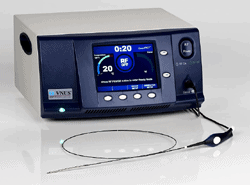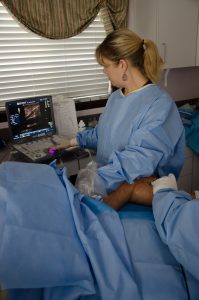VNUS Radiofrequency (RF) Ablation

RF vs EVLT vs Vein Glue
Currently three main technologies have come to the forefront. The first is Radiofrequency (RF) ablation, usually referred to simply as RF or RF ablation. In terms of vein disease, “ablation” means “to close down” or “to collapse.” The second is Endovenous Laser Treatment, usually referred to as EVLT or laser ablation. It’s the second main ablation technique in wide use today. The third technique uses surgical grade adhesive to permanently seal diseased veins shut. This type of treatment is informally known as “vein glue.” While this may sound unsafe, the adhesives used are exactly the same as those used in brain surgery.
VNUS Radiofrequency (RF) Ablation Most Popular
Each technique has strengths and weaknesses, yet all are vastly superior to stripping. Of the three, Radiofrequency ablation, RF, is probably the most popular.
The VNUS® RF Ablation system, also known as the Closure® technique, is now in particularly wide use. It’s designed for safety, ease of use, and has delivered hundreds of thousands of successful treatments to date. As with all RF systems, it relies on radiofrequency energy to collapse diseased veins. Blood is immediately rerouted to nearby healthy veins, and overall circulation is improved. In a matter of weeks, the treated veins are reabsorbed into the body via the natural healing process.
VNUS Radiofrequency (RF) Ablation Procedure
To begin, Doppler ultrasound, which excels at imaging blood vessels, is used to map out a patient’s leg veins. Since Doppler is capable of measuring blood flow it’s able to pinpoint exactly which veins need treatment. Once this is done, a thin, flexible catheter with a heating element at the tip is inserted into the vein. Electricity is then run through the catheter. This is immediately converted into Radiofrequency energy which produces highly focused heat at whatever intensity the surgeon requires.
When this heat is delivered it causes the proteins which make up the vein walls to contract and collapse. As the catheter is slowly withdrawn the vein closes behind it, sealing it shut along its entire length. In medical terms this process is known as ablation. As mentioned, blood flow is rerouted to nearby healthy veins, and the diseased veins are eventually reabsorbed. Once ablated, the physical symptoms associated with vein disease lessen dramatically, often disappearing completely.
VNUS Radiofrequency (RF) Ablation Advantages
One of the main advantages of the ablation procedures is that only local anesthesia is required. There’s no need for general anesthesia (being put under), so a hospital stay isn’t necessary. This means that the procedure can be done on location in your surgeon’s office. Patients can (and should) walk immediately afterwards, and normal, low-intensity activities can begin within 24 hours. Vigorous exercise can be resumed in about 2 weeks.
For all practical purposes Radiofrequency ablation has replaced highly invasive vein stripping. Even newer, improved forms of stripping such as PIN (Perforate Invaginate Stripping) can’t compete.
Can radiofrequency ablation be used for cosmetic purposes?
Radiofrequency ablation (RFA) is primarily a medical procedure used for therapeutic purposes rather than cosmetic applications. It is commonly employed for pain management, particularly in cases of chronic pain resulting from conditions such as arthritis or nerve damage. However, radiofrequency technology does have some cosmetic applications, although they are not strictly referred to as “ablation.”
In the realm of aesthetics, radiofrequency energy is often utilized for skin rejuvenation and tightening. This technique is commonly known as radiofrequency skin tightening or radiofrequency facial. During the procedure, radiofrequency energy is delivered to the targeted areas of the skin, stimulating collagen production and promoting tissue remodeling. This can result in a reduction of fine lines, wrinkles, and sagging skin, leading to a more youthful appearance.
Radiofrequency skin tightening is a non-invasive or minimally invasive option that offers several benefits. It can be used on various body areas, such as the face, neck, abdomen, and thighs. The treatment is generally well-tolerated, with minimal discomfort and downtime. Results are often gradual and may require multiple sessions for optimal outcomes.
It’s important to note that while radiofrequency skin tightening can enhance the appearance of the skin, it may not provide drastic changes comparable to surgical procedures like facelifts. It is best suited for individuals seeking subtle improvements without undergoing invasive surgery.
Before considering radiofrequency for cosmetic purposes, it is advisable to consult with a qualified aesthetic professional or dermatologist to determine if it is the appropriate option for your specific concerns and goals.
How long does the pain relief typically last after radiofrequency ablation?
The duration of pain relief after radiofrequency ablation can vary depending on the individual and the specific condition being treated. In many cases, patients experience pain relief for several months to a year or longer. However, the exact duration can differ from person to person.
Risks of VNUS Radiofrequency (RF) Ablation
With any surgery there’s a small amount of risk involved. Another of the major advantages of RF ablation is the extremely low incidence of side effects and complications. Any that do occur tend to be very mild. The main side effect of this type of procedure include swelling, bruising, and numbness. This numbness is temporary, typically resolves in a few weeks, and only occurs in a small minority of cases.
Complications of VNUS Radiofrequency (RF) Ablation
Severe complications such as the formation of blood clots in the legs are possible, yet highly unlikely. This primarily refers to Deep Vein Thrombosis (DVTs), which can sometimes break loose and become lodged in the lungs. This is known as a Pulmonary Embolism (PE), and is potentially life threatening event. Events like DVTs and PEs are extremely rare, and occur almost exclusively in patients entering into the procedure in very poor health.
Benefits of VNUS Radiofrequency (RF) Ablation
As previously stated this approach has all of the benefits of vein stripping with none of the drawbacks. In each case the faulty vein is removed or is otherwise gone from the body. It’s simply not there anymore, and the blood is rerouted to healthier veins. This often eliminates symptoms such as swelling, achiness and heaviness completely.
The following are benefits of radiofrequency ablation:
- pain reduction
- no surgery
- Almost no recuperation period.
- reduced need for painkillers.
- improved performance.
- After a day or two of recuperation, get back to your normal routine.
Post Op Instructions after VNUS Radiofrequency (RF) Ablation
Compression therapy plays a role in most leg vein treatments. What this actually means is that prescription compression stockings must be worn after even minimally invasive procedures. These include Radiofrequency ablation mentioned above, laser ablation, sclerotherapy. Even outdated, highly invasive vein stripping required patients to wear stockings, usually for much more than 2 weeks.
For the first 2 days following your procedures the stockings should be worn constantly, removing them only to bathe. During the remainder of the week the patients can remove the stockings at night, if desired. After about 2 weeks the patient is advised to wear the stockings “during the day” meaning about 8-12 hours. At this point the vast majority of patients are cleared to continue all activities without restriction.
Alternately, a health conscious patient (especially one who’s on their feet all day) can continue compression therapy. It’s virtually impossible to overdo mild-moderate compression and it will benefit most patients. When worn on a daily basis, prescription stockings can improve any patient’s circulation and overall vein health.
Heavy lifting and strenuous activity should be avoided immediately following the procedure. Patients are instead asked to begin weight bearing and gently walking as soon as possible—usually within minutes. In conjunction with compression therapy (stockings), this reduces discomfort, increases circulation, and reduces swelling. It also helps lower the already small chance of complications including the formation of blood clots, a medical emergency. In almost all cases patients are cleared to return to light duty, i.e. office work, immediately after their surgery.
What Should I Know About VNUS Radio Frequency Ablation?
Here are some important things you need to know before you seek for RFA treatment, everything mentioned here is positive so be not afraid.
There is little to no discomfort.
The doctor will treat the area with local anaesthetic prior to the RFA process, so you shouldn’t feel anything. If you experience any pain or discomfort after that, it will be little.
hardly any downtime
After RFA for varicose veins, your doctor would probably advise you to resume your regular activities within 24 hours. The day after your procedure, you can carry on as usual. You should avoid strenuous exercise or heavy lifting for about a week.
Bruising is kept to a minimum.
In terms of post-procedural bruising and swelling, radiofrequency ablation is better to other surgical and non-surgical procedures for treating varicose veins. Any little swelling or bruising should go away within 10 to 14 days.
Quick and secure
RFA is an outpatient procedure that takes about 35 to 40 minutes to complete. The procedure’s non-surgical nature eliminates the hazards associated with surgery.
General anesthesia is not required
The risks of disorientation, pneumonia, stroke, and heart attack increase for older people and people with major medical conditions when under general anesthesia. These hazards are eliminated by RFA because it does not require general anesthesia for the treatment of varicose veins.
Invasiveness is kept to a minimum.
The tiny 14-inch incision required for RFA can treat a vein up to 30 inches in length.
Is venous radiofrequency ablation painful?
Venous radiofrequency ablation is generally well-tolerated and not very painful. Local anesthesia is used to numb the treatment area, which helps minimize discomfort during the procedure. Some patients may experience mild discomfort or soreness after the procedure, which can be managed with over-the-counter pain medications. However, pain levels can vary depending on individual sensitivity, the extent of the procedure, and other factors.
It’s Important to note that pain or discomfort associated with venous radiofrequency ablation is typically temporary and resolves within a few days to a week. If you have concerns about pain or discomfort during or after the procedure, it’s best to discuss them with your healthcare provider, who can provide appropriate guidance and recommendations. Following post-procedure care instructions and wearing compression stockings as advised by your healthcare provider can also help manage any discomfort and promote a smooth recovery.
Can venous radiofrequency ablation be done on any vein in the body?
Venous radiofrequency ablation is typically used to treat veins in the legs, particularly the great saphenous vein, which is a common site of venous insufficiency. It may not be suitable for all veins in the body, as the procedure requires access to the vein using a catheter and specialized equipment. The specific veins that can be treated with venous radiofrequency ablation will depend on the location, size, and condition of the veins, as well as the evaluation and recommendation of a qualified healthcare provider. It’s important to consult with a healthcare provider to determine the most appropriate treatment options for your specific condition.
What is the recovery process like after venous radiofrequency ablation?
Recovery after venous radiofrequency ablation is typically relatively quick. Most patients can resume normal activities within a day or two, although strenuous exercise and heavy lifting should be avoided for a week or two. Wearing compression stockings and following post-procedure care instructions from your healthcare provider is also usually recommended.
How long does it take to recover from endovenous laser therapy?
Patients are urged to begin walking right away after the surgery, but they should refrain from any demanding leg workouts for two to three weeks in order to give their legs enough time to heal and for the treated veins to remain closed. In the treated limb, there is bruising and minimal discomfort for two to four weeks.


